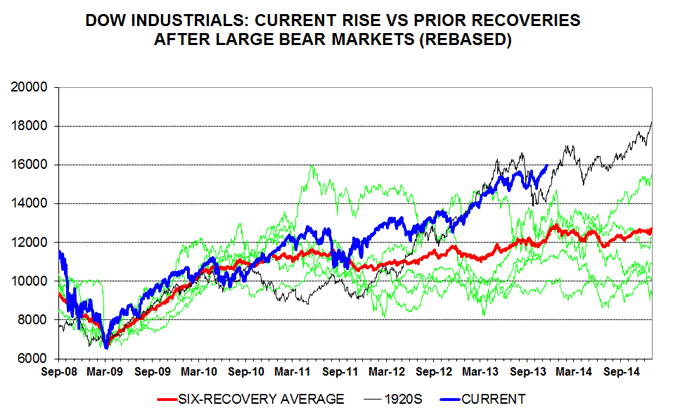Entries from November 1, 2013 - November 30, 2013
UK's Carney should worry about dishoarding, not mythical mortgage boom
UK monetary conditions remain expansionary but this does not reflect any boom in mortgage lending – yesterday’s changes to the funding for lending scheme, although probably inconsequential, were misguided.
Six-month growth of real non-financial M1* – the favoured monetary aggregate here – eased back in October but remained robust at 4.4%, or 9.1% annualised. Growth of real non-financial M4 is much lower but was little changed in October at 1.0%, or 1.9% annualised – see first chart.
As in the Eurozone but to a greater extent, economic strength is being driven by households and firms “dishoarding”, i.e. mobilising existing monetary savings, rather than by rapid expansion of broad money and credit. Such dishoarding involves a shift of funds out of time deposits and notice accounts into M1, explaining its superior forecasting performance. Put differently, the velocity of circulation of the existing stock of broad money is increasing.
Credit weakness is gradually abating but the stock of net lending to individuals, excluding student loans, grew by only 1.6% annualised in the latest three months. Talk of a borrowing binge, in other words, is nonsense. As previously discussed, repayments of mortgage debt have risen more or less in line with gross advances, resulting in little change in the net lending flow – second chart.
If economic strength caused by dishoarding / rising velocity is judged to pose an inflationary risk, the appropriate policy action is to raise Bank rate rather than throw another spanner in the credit machinery. A Bank rate hike would filter through to deposit rates, reducing the incentive to spend monetary savings. The knock-on effect on borrowing rates could be mitigated by making funding for lending and the capital regime more, not less, generous.
*Non-financial M1 = sterling notes / coin and sight deposits of households and private non-financial firms. M4 = M1 plus other sterling deposits, repos, bank bills / commercial paper and other bank securities of up to five years’ original maturity.
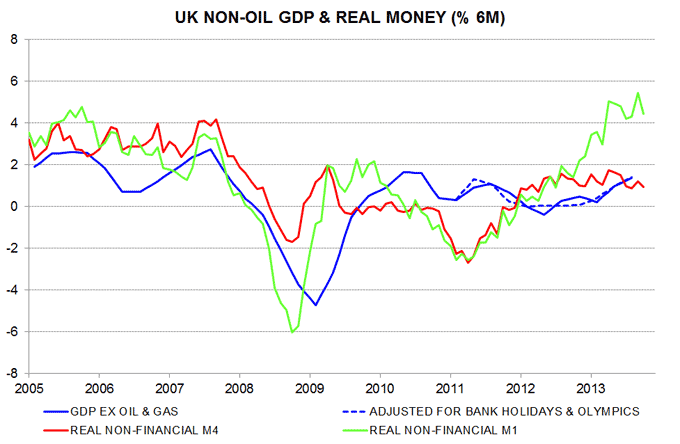
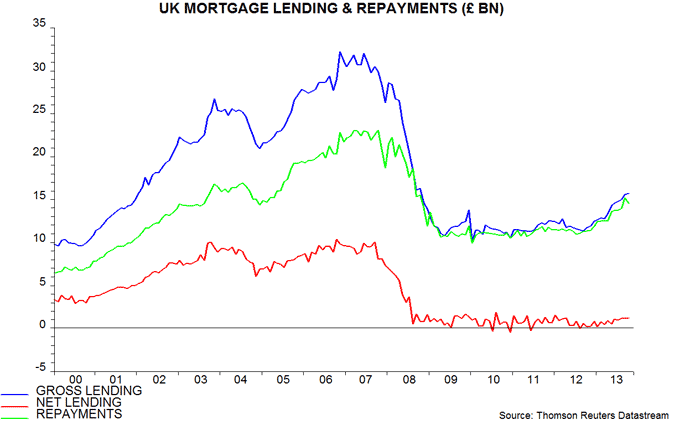
Eurozone money numbers: economic recovery reflects "dishoarding"
Eurozone monetary trends are judged here to be consistent with a continued but sluggish economic recovery in early 2014.
Consensus commentary is likely to view October numbers as poor, since the annual rates of change of broad money M3 and loans to the private sector* fell – from 2.0% to 1.4% and -1.6% to -1.7% respectively. Narrow money M1, however, has far superior forecasting properties and continues to expand respectably – by an annual 6.6% in October versus 6.7% in September. The shorter-term trend, moreover, is stronger – M1 rose by 1.0% in October alone and by 1.9%, or 7.8% annualised, in the latest three months.
ECB research** has identified real (i.e. inflation-adjusted) non-financial M1, comprising holdings of households and non-financial firms, as the best monetary leading indicator of the economy. Six-month growth of this measure has eased since May but remained solid at 2.9%, or 6.0% annualised, in October – see first chart.
The interpretation here is that weak credit supply and demand are continuing to depress lending and broad money but this is not preventing an economic recovery because households and firms are mobilising existing monetary resources to increase spending. Such “dishoarding” is a response to low interest rates and increased confidence in financial stability, and is being reflected in an ongoing transfer of funds out of time deposits and notice accounts into M1.
Deflation worries, accordingly, are exaggerated. Current low inflation is mainly the consequence of monetary restriction in 2011, when the ECB raised official rates despite weakness in both M1 and M3. Stronger M1 growth in 2012-13 suggests that inflation will stabilise and firm in 2014-15. Downside risk stems not from domestic monetary conditions but from upward pressure on the euro / dollar exchange rate, caused partly by the Federal Reserve reneging on its commitment to taper QE.
The country breakdown of M1 deposits continues to show slower real growth in the peripheral grouping (i.e. Italy, Spain, Greece, Portugal, Ireland) but September weakness was partially reversed last month – second chart. Italy / Spain are lagging Germany / France, although divergences are small by the standards of recent years; growth, by contrast, is strong in the three IMF bailout countries – third chart.
*Adjusted for sales and securitisation.
**See “Stylised facts of money and credit over the business cycle”, ECB Monthly Bulletin October 2013, pp18-22.



UK mortgage lending pick-up offset by increased repayments - net lending still weak
As previously discussed, the commonly-held view that recent stronger UK economic growth reflects consumers gearing up to finance higher spending is not supported by evidence. The stock of lending to individuals, excluding student loans, rose by only 1.0% in the year to September*, while employee compensation – the product of average compensation and employee numbers – gained an annual 3.6% in the third quarter, according to today’s national accounts release.
Undaunted, the debt worriers argue that lending is about to take off, citing a recent surge in mortgage approvals – up by 35% in value terms in the year to September according to comprehensive Bank of England data, with British Bankers’ Association members this week reporting a 31% increase in October. As explained below, however, this surge has already largely fed through to gross mortgage advances but net lending has remained weak. A rise in loan repayments, in other words, has offset the pick-up in gross lending. Stronger net lending, therefore, requires either a further increase in approvals or a slowdown in repayments.
Mortgages on dwellings account for 89% of the stock of lending to individuals. Gross mortgage advances were £15.6 billion in September versus a monthly average of £11.9 billion in 2012, an increase of 31%. Mortgage approvals rose only slightly more over the same period – from £12.0 billion to £16.0 billion, or 33%. So gross advances already largely reflect recent higher approvals.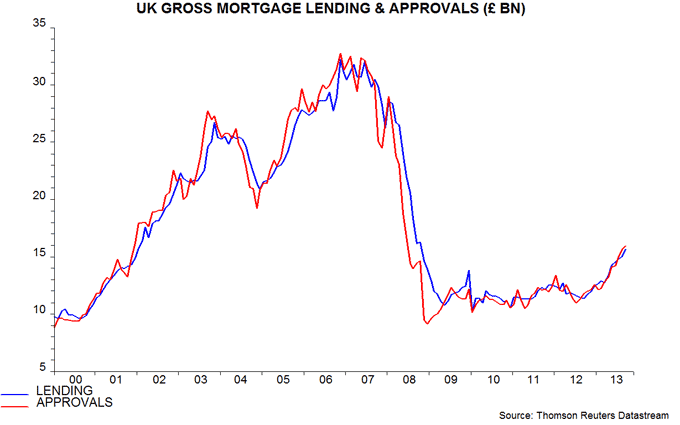
Net lending, by contrast, remains weak – £1.0 billion in September versus a 2012 average of £700 million. A rise in principal repayments has almost exactly matched the pick-up in gross advances.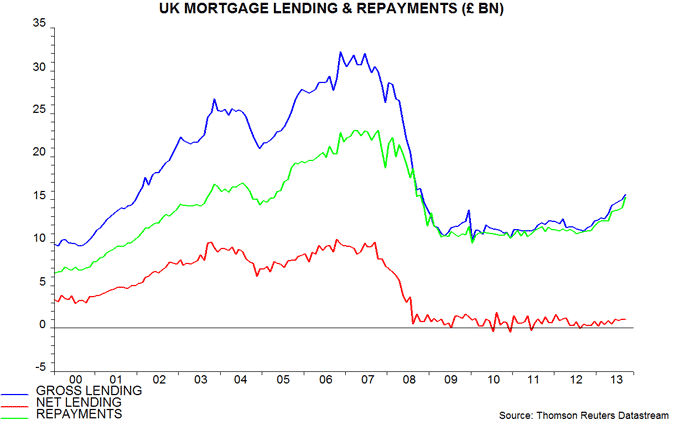
The next chart breaks the principal paydown into redemptions and other repayments. Both have increased this year. The rise in redemptions is mostly due to higher remortgaging activity as the funding for lending scheme has allowed borrowers to refinance on more attractive terms. Regular repayments, however, have also increased significantly. This may partly reflect borrowers who have refinanced at a lower interest rate maintaining their monthly payments, resulting in a larger repayment component.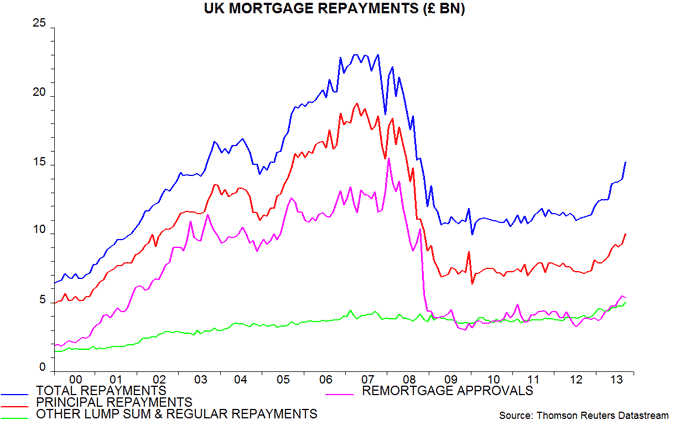
Assuming that repayments continue at their current rate, mortgage approvals need to rise significantly further to signal that consumers are regearing. Consider a scenario in which overall lending growth strengthens from an estimated 1.25% during 2013 (i.e. December to December) to 5% in 2014, with the increase driven by mortgage credit. 5% lending expansion would require a monthly net mortgage flow of £5.1 billion versus £1.0 billion in September 2013. So gross mortgage lending and approvals would need to rise by a further £4.1 billion per month, or 26%.
5% lending growth, of course, would be modest by historical standards and might not exceed income expansion, assuming a continued economic pick-up. A 10% lending increase would require mortgage approvals to climb by more than 60% from the September level.
The help to buy guarantee scheme should contribute to mortgage approvals strengthening further but a rise of 26%, let alone 60%, is doubtful. The government announced earlier this month that 2,384 borrowers had mortgages approved under the scheme in the first four weeks of its operation. This amounts to 3.0% of the number of mortgage approvals for house purchase in September (66,735). Some of these borrowers would probably have obtained mortgages in the absence of the scheme, albeit on more expensive terms.
*October money and lending data are released on Friday.
Could the next BoE interest rate move be a cut not rise?
A cut in Bank of England official rates is not the central expectation here, and is certainly not recommended, but is worth considering for the following reasons:
-
Other central banks have made or are considering changes to remuneration arrangements for bank reserves and the Bank of England is a devoted follower of fashion. The ECB this month lowered its main refinancing rate, which is also the rate paid on required reserves, from 0.5% to 0.25%, while President Draghi stated that a cut in the rate on excess reserves (i.e. the deposit facility rate) from zero to negative was discussed. The latest FOMC minutes, meanwhile, revealed that “most participants thought that a reduction by the Board of Governors in the interest rate paid on excess reserves could be worth considering” in order to anchor short-term interest rates and reinforce the Committee’s forward guidance.
-
The ECB cut means that the rate paid on UK reserves is the highest of the major central banks. The Bank of England pays Bank rate of 0.5% on reserves versus 0.25% / 0.25% on required and excess reserves in the US, 0.25% / 0% in the Eurozone and 0% / 0.1% in Japan. The MPC may be concerned that a widening differential is contributing to upward pressure on sterling.
-
The MPC believes that the rising rate path discounted in markets is too hawkish and is acting as an unnecessary growth drag. This was signalled in the November Inflation Report by a mean forecast that inflation would be slightly below target in two years’ time if Bank rate followed the market-implied path. Market rates have failed to adjust lower despite Governor Carney reaffirming dovish forward guidance. An official rate cut could “shock” markets into accepting the MPC’s desired rate path and could be defended as a response to recent lower-than-expected inflation.
-
The MPC has previously ruled out a cut in Bank rate on the grounds that it could constrict credit supply by reducing the profitability of some lenders, especially building societies. The funding for lending scheme, however, has allowed lenders to widen margins, possibly lessening this concern.
The Bank could choose simply to cut Bank rate by 25 basis points to 0.25% but would be more likely to emulate the ECB by reintroducing reserve requirements, paying a lower rate on excess balances held in the standing deposit facility – maintaining Bank rate, and the rate on required reserves, at 0.5% would mitigate point 4 above. Setting the deposit rate at 0.25% would result in the overnight rate dropping to about this level from 47 basis points currently, with a knock-on effect along the money market yield curve.
UK vacancy rate suggests limited labour market slack
The November Inflation Report reaffirmed the MPC’s view that there is significant “effective” slack in the UK labour market. This view rests partly on an estimate that the “medium-term equilibrium unemployment rate” – a measure relevant for assessing wage pressures over the MPC’s three-year forecast horizon – is currently 6.5% versus an actual rate of 7.6% in the third quarter of 2013. This suggests that the MPC will allow unemployment to fall beneath the 7.0% forward guidance threshold before raising interest rates, and may even lower the threshold as the actual rate approaches this level.
An alternative employer-based measure of labour market slack is the vacancy rate – the stock of unfilled positions expressed as a percentage of the number of filled employee jobs. If effective labour supply were much higher than demand, as the MPC believes, employers would find it easy to fill job openings and the vacancy rate would be low and stable. It has, in fact, risen significantly over the last 18 months – from 1.65% in the first quarter of 2012 to 1.9% in the third quarter of 2013. The latter matches the fourth quarter of 2008, suggesting that labour market slack is similar now to then. This is at odds with the message from the unemployment rate, which is 1.2 percentage points above its level of 6.4% in the fourth quarter of 2008.
The first chart compares the unemployment and vacancy rates since 1995, with the latter plotted inverted*. The scales have been adjusted to align the 1995-2013 averages of the two series. The current vacancy rate of 1.9% is only 0.1 percentage points below its 2.0% average, suggesting that – from the perspective of employers – labour market conditions are close to normal. The unemployment rate of 7.6%, however, remains far above its 6.4% average – close to the MPC’s current estimate of the “medium-term equilibrium rate”.
The message from the vacancy rate accords with business survey evidence. In the third quarter British Chambers of Commerce survey, the seasonally-adjusted percentage of manufacturers reporting recruitment difficulties was above its post-1995 average, while the services percentage was below average by the smallest margin since the fourth quarter of 2008.
The second chart shows the vacancy rate – no longer inverted – and annual growth of inflation-adjusted regular earnings (i.e. excluding bonuses). Real earnings started to contract as the vacancy rate moved below average in late 2008. On current trends, the rate will rise above 2.0% during the first half of 2014, suggesting that nominal earnings growth will recover and move above inflation later next year.
A resumption of real earnings expansion would, of course, provide welcome relief for hard-pressed consumers but would need to be matched by improved productivity performance to prevent upward pressure on unit labour costs / prices, or else a further squeeze on profits. The view here is that, in addition to being too sanguine about labour market slack, the MPC is overoptimistic about productivity prospects – available evidence suggests continued weakness in the third quarter despite strong economic growth, as noted in a post last week.
*The vacancy rate was estimated before the second quarter of 2001 by linking the current employer survey based vacancies series with an earlier series, ending in the first quarter of 2001, covering vacancies at job centres. This linking assumes that 1) the vacancy rate was unchanged between the first and second quarters of 2001 (reasonable – unemployment was little changed between the two quarters) and 2) job centre vacancies were a constant proportion of total vacancies from 1995 to 2001.
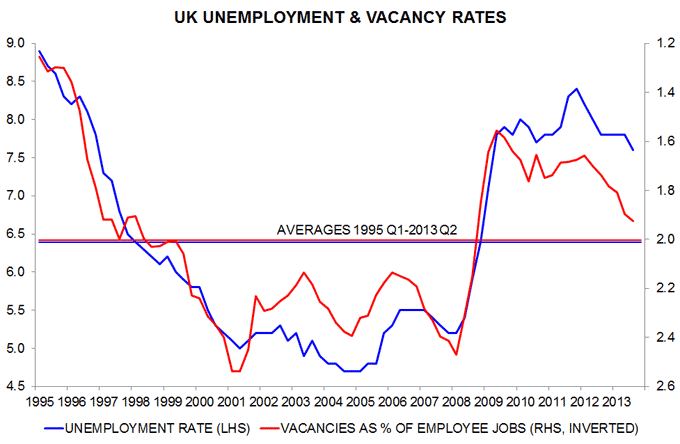
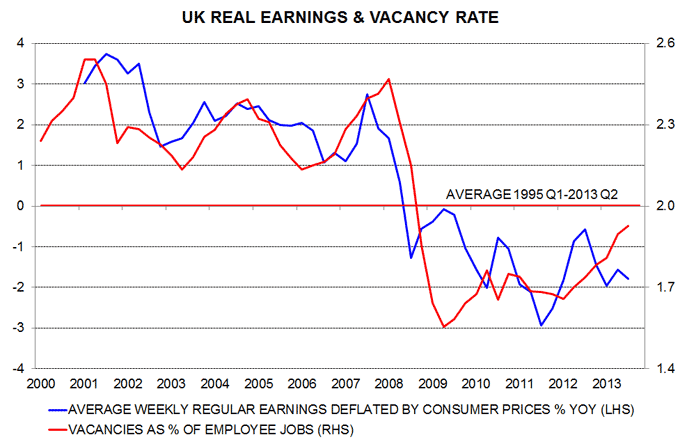
US stock market rise stretched relative to history
Previous posts have compared the rise in the Dow Jones Industrials index from its March 2009 low with increases after six previous bear markets involving a peak-to-trough fall of about 50%. (The Dow declined by 54% between October 2007 and March 2009.) As explained below, the Dow is currently outpacing these prior rises.
The six bear market troughs considered in this analysis occurred in November 1903, November 1907, December 1914, August 1921, April 1942 and December 1974. The Dow Industrials fell by between 45% and 52% into these lows. (The 1929-32 bear market was excluded because it involved a much larger decline, of 89%.) In each of the six cases, the trough of the bear market was rebased and shifted forwards in time to match the March 2009 low. The subsequent rises were then traced out and an average calculated – see chart.
This “six-recovery average” proved to be a good guide to the underlying trend in US stocks over the two-and-a-half years following the 2009 trough. Since late 2011, however, the Dow has diverged positively from the average and is currently above the top of the range spanned by the historical rises.
The closest resemblance is to the “roaring twenties” increase from the August 1921 trough – the black line in the chart. The equivalent month to November 2013 was May 1926. If the Dow were to replicate its performance then, it would rise to 17,000 in February 2014 before falling back to 15,000 in April. It would make no net progress between now and July 2014.
The fall from the equivalent of 17,000 to 15,000 occurred in September-October 1926 as the US economy was entering a 13-month recession. This recession followed a rise in short-term interest rates – the three-month Treasury bill rate increased from less than 2% in 1924 to more than 3.5% – and a stagnation of the narrow money supply.
Bulls argue that there is no recession in sight while unprecedented central bank monetary manipulation will continue to force investors into equities, making historical comparisons redundant. The assessment here is more cautious: longer-term bond yields have risen significantly, the global real money supply is no longer outpacing output and growth may be reaching a peak – see yesterday’s post. The historical suggestion that the Dow is overstretched and will, at best, tread water through mid-2014 may prove more than a curiosity.